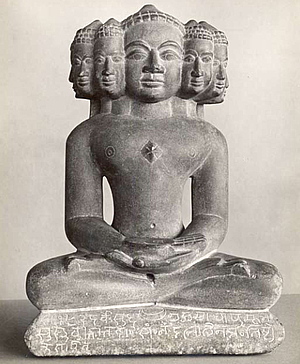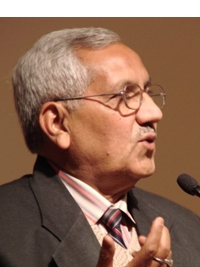
Centre of Jaina Studies Newsletter: SOAS - University of London
During my visit to the United Kingdom as a Nehru Trust Fellow some years back I had the privilege to visit different museums in the UK, including the reserve collection of the Victoria and Albert Museum, London.[1] The collection holds a unique seven-headed stone sculpture of a Tīrthaṅkara, seated in dhyāna-mudrā with both hands in the lap (Fig. 1). Stylistically the provenance of this image should be western India. The sculpture bears the śrīvatsa mark in the centre of the chest, and there is an inscription on the pedestal, dated in saṃvat 1526 (=1469 CE). Surprisingly, the Tīrthaṅkara sits simply on a low pedestal without a siṃhāsana (lion-throne), tri-chatra (three-tiered parasol), prabhāmaṇḍala or any other prātihārya (associated attending feature).
What makes this icon unique is that it has seven faces, three on each side of the central face. The seven faces are obviously suggestive of the renderings of seven Tīrthaṅkaras (Jinas) which would be from the first (Ādinātha) to the seventh (Supārśvanātha). But what is more surprising is the rendering of the crescent cognizance (lāñchana of Candraprabha) on the pedestal and the mention of the name of Candraprabha (8th Jina) in the pedestal inscription.[2] This indicates that the principal Tīrthaṅkara in the image is Candraprabha, while the other flanking faces represent six other Tīrthaṅkaras. Who are these Tīrthaṅkaras? These could not be identified in the absence of any indication or cognizance. All seven faces have a serene appearance and curly hair with protuberance.
The icon is apparently a composite (saṃghāṭa) representing seven Tīrthaṅkaras together wherein Candraprabha, carved in the centre with cognizance, is the principal. Although no Jaina text refers to any form of Tīrthaṅkara image having more than one face, it is very likely that in the spirit of Brahmanical composite images showing two or more deities carved together,[3] the Jainas also attempted such composite images wherein more than one Tīrthaṅkara was represented.
It would be relevant to mention here that sculptures of composite Jinas were carved in the Kuṣāṇa period.[4] The Jina caumukhī (or pratimā-sarvatobhadrikā) icons of the Kuṣāṇa period represent the figures of four different Tīrthaṅkaras, standing in kāyotsarga-mudrā on four sides, two of which are distinctly identifiable with Ādinātha (1st Tīrthaṅkara with hanging hair locks) and Pārśvanātha (23rd Tīrthaṅkara with seven-hooded snake canopy).[5] From about the seventh century CE onwards such dvitīrthī and tri-tīrthī Tīrthaṅkara images were also carved, which show two or three Tīrthaṅkaras together (mostly standing) in one image. Such composite images are found in Mathurā, Deogaṛh, Chāndpur, Chandheri, Siron Khurd, Arang, Khajurāho and many other places.

Figure 1. Seven-Faced Tīrthaṅkara
Saṃvat 1526 (=1469 CE)
Victoria and Albert Museum,
London Acc. No. 451(IS)
Image © Victoria and Albert Museum
In another form of composite Tīrthaṅkara image, found in Mathurā (in U.P.) Sonbhandār Cave and Rājgir (in Bihar), the cognizance on the pedestal is of one Tīrthaṅkara, while in the same image yakṣa-yakṣī like Kubera-Ambikā, or figures of Balarāma and Vāsudeva Kṛṣṇa, or even a seven-hooded snake canopy represent some other Tīrthaṅkara. In such composite images mostly Ādinātha-Neminātha, Sambhavanātha-Supārśvanātha, Ajitanātha-Pārśvanātha, and Munisuvrata-Neminātha Tīrthaṅkaras are shown.[6]
Hence the present seven-headed Tīrthaṅkara image in the reserve collection of the Victoria and Albert Museum is merely the progressive continuation of the practice of rendering composite Tīrthaṅkara images in Jaina art, about which, however, Jaina texts are completely silent. Such composite Tīrthaṅkara images suggest that all the Tīrthaṅkaras are virtually one and the same. Therefore they should be worshipped with equal reverence and devotion with advaita-bhāva (feeling of non-duality).
The rendering of composite Tīrthaṅkara images was a purposeful innovation by Jaina ācāryas and artists, and the present image is an outstanding rare example of the same.
Maruti Nandan P. Tiwari is a Professor at the Department of Art History at Banaras Hindu University Varanasi, India.
M. N. P. Tiwari, "Jaina Sculptures and Painting in the United Kingdom", Kalā (Journal of Indian Art History Congress), Vol. III, 1996-97, pp. 40- 48.
1. saṃvat 1526 vai su ṣaṣṭhi, Candraprabha dhātu 2. suvāstu saṁyutta helā dhyānamnuṣṭhitam 3. anujñāpitam Translated as: 'The image of Candraprabha was installed in the temple in Saṃvat 1526 (=1469 CE) on the bright 6th day of the month of Vaiśākha'. This reading is courtesy of Professor Sita Ram Dubey, Chairman of the Department of Ancient Indian History, Culture & Archaeology, Banaras Hindu University, Varanasi. Editor's Note: Two alternative readings of the inscription have been suggested:
(a) The Victora and Albert Museum has the following partial decipherment made in 2006 by Professor Gouriswar Bhattacharya: saṃ 1[9]25 vai. śu 6 guruṣu(?) /...... saṃ naṃdatolena a. tiṣye karāpita. Translated as: "In the year l[9] 25 (i.e. 1[8]68 A.D.), on Thursday, the 6th day of the bright half of (the month of) Vaiśākha, the image was caused to be made by Nandatola in the....tiṣya-nakṣatra." (b) Professor J.C. Wright suggests a different reading of the text, written in Kaithī, not Nāgarī, script: saṃ 1825 vai° su 6.... .... -ena pra°tiṣṭhā karāpitaṃ. Translated as: "6th day of waxing moon in Vaiśākha VS 1825 [23.4.1768]...... commissioned and installed by...." Professor Wright also notes: "The pra°tiṣṭhā is evidently a truncated version of pratiṣṭhāpitaṃ (with a misplaced abbreviation symbol after pra-). We just possibly have saptaśīrṣā 'seven-headed' at the start of the second line (a Ṛgvedic epithet, applied in epic to Viṣṇu). I don't think it is possible to go further than that. There may indeed be a naṃda- in the name of the commissioning agent, but that is quite uncertain until one deciphers the rest. The script seems quite in keeping with the apparent Vikrama date. There is no trace of 'Candraprabha'". All three readings agree that only the symbol of the half-moon, inserted after the date, and the śrīvatsa symbol one should add, could point to Candraprabha.
Such as Ardhanārīśvara, Harihara, Hariharapitāmaha, and Hariharahiraṇyagarbha. See: J. N. Banerjea, The Development of Hindu Iconography, Calcutta, 1956, pp. 540-63.
Maruti N.P. Tiwari, "Jaina Iconography in Kushana Age", Jaina Vidyā, Lucknow, No. 1, 1998, pp. 106-116.
 Prof. Dr. Maruti Nandan P. Tiwari
Prof. Dr. Maruti Nandan P. Tiwari